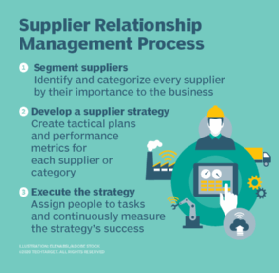multisourcing (multi-sourcing)
What is multisourcing?
Multisourcing (multi-sourcing) is an approach to outsourcing in which IT operations and technology infrastructure are contracted to a number of vendors, usually in combination with some internally provided elements of information technology.
The multisourcing approach contrasts with fully in-house IT provisioning and sole-source outsourcing models.
How does multisourcing work?
Often, a company's IT vendor management office will oversee its multisourcing arrangements with input and guidance from its legal team, IT staff and other executive leadership.
A good starting point is to select service delivery providers with similar corporate cultures.
In addition, organizations pursuing a multisourcing arrangement should craft strong internal corporate governance strategies with regard to IT vendor relationships and share the details with all of their service providers.
This promotes better cooperation and more seamless delivery of services across organizational lines.
The benefits of multisourcing
Here are some of the common benefits of successful multisourcing for the business process.
Risk mitigation
Dependency on a single vendor or one supplier leads to high risk. Multisourcing can aid enterprise risk management and serve as a better sourcing strategy than single sourcing.
For example, if procurement of raw materials is done through a single supplier, it will have a high impact on the proper functioning of the supply chain. If the vendor does not deliver on time, it can cause supply chain disruption.

Optimization
The purpose of multisourcing is to maximize the effectiveness of an enterprise's IT by ensuring that various elements are sourced to the best possible providers while allowing the enterprise to maintain its focus on core competencies.
Lower costs
Multisourcing practices can promote competition among various providers. It might give an incentive to vendors to cut costs related to repetitive service contracts, bringing cost savings to the business.

The challenges of multisourcing
There are also several challenges associated with a multisourcing strategy.
Difficulty maintaining supplier relationships
When an organization spreads its business across many vendors, it becomes more challenging to manage them all effectively. Thus, due to its nature, multisourcing can make it difficult to build and nurture good relationships with multiple suppliers simultaneously.
Potential for increased overhead costs
As an organization adds more service providers, it may find that its internal IT staff is unable to manage all the relationships or all the services provided. Thus, the multisourcing approach can lead to increased overhead costs as a result of hiring more staff or engaging more third-party consultants.
Loss of control
Organizations can lose some control when business processes are managed by multiple service providers. For example, the organization might not be able to dictate the specific technology platforms or applications that will be used to deliver services.
Integration difficulties
When several suppliers handle different aspects of a product, integrating them may be difficult, resulting in extra expenses and time.
See also: nearshore outsourcing, onshore outsourcing, offshore outsourcing, business process outsourcing, IT outsourcing strategy.





